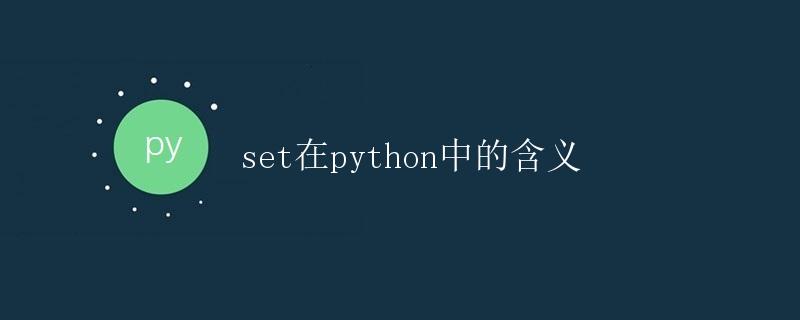set在Python中的含义

1. 概述
在Python中,一个集合(set)是一种无序且不重复的数据类型。它是由多个元素组成的,这些元素可以是任何不可变的数据类型,例如整数、浮点数、字符串等。与列表(list)和元组(tuple)不同,集合不包含重复的元素。
在本篇文章中,我们将探讨set在Python中的含义、用途、操作以及一些常见的示例。
2. 创建set
在Python中,可以通过使用大括号({})或set()函数来创建一个空的集合。下面是几种创建set的方式:
# 创建空的set
empty_set = set()
print(empty_set) # 输出: set()
# 使用花括号创建set
my_set = {1, 2, 3, 4}
print(my_set) # 输出: {1, 2, 3, 4}
3. set的特点
- 集合中的元素是无序的,即无法通过索引访问元素。
- 集合中的元素是唯一的,重复的元素会被自动剔除。
- 集合中的元素必须是不可变的,例如整数、浮点数、字符串等,不能包含可变的数据类型如列表。
# 重复元素自动被剔除
my_set = {1, 2, 2, 3, 4}
print(my_set) # 输出: {1, 2, 3, 4}
# 可变类型如列表无法作为set的元素
invalid_set = {[1, 2], 3, 4} # 报错: unhashable type: 'list'
4. set的操作
4.1 添加元素
使用add()方法向集合中添加单个元素,使用update()方法向集合中添加多个元素。
my_set = {1, 2, 3}
my_set.add(4)
print(my_set) # 输出: {1, 2, 3, 4}
my_set.update([5, 6, 7])
print(my_set) # 输出: {1, 2, 3, 4, 5, 6, 7}
4.2 删除元素
使用remove()方法根据元素值删除指定元素。如果要删除的元素不存在会抛出KeyError异常。另外,也可以使用discard()方法删除元素,如果元素不存在不会报错。
my_set = {1, 2, 3, 4, 5}
my_set.remove(3)
print(my_set) # 输出: {1, 2, 4, 5}
my_set.discard(2)
print(my_set) # 输出: {1, 4, 5}
4.3 集合运算
集合支持基本的数学运算,例如并集、交集、差集和对称差等。
- 并集:使用union()方法或者|运算符
set1 = {1, 2, 3} set2 = {3, 4, 5} union_set = set1.union(set2) print(union_set) # 输出: {1, 2, 3, 4, 5} or union_set = set1 | set2 print(union_set) # 输出: {1, 2, 3, 4, 5} - 交集:使用intersection()方法或者&运算符
set1 = {1, 2, 3} set2 = {3, 4, 5} intersection_set = set1.intersection(set2) print(intersection_set) # 输出: {3} or intersection_set = set1 & set2 print(intersection_set) # 输出: {3} - 差集:使用difference()方法或者-运算符
set1 = {1, 2, 3} set2 = {2, 3, 4} difference_set = set1.difference(set2) print(difference_set) # 输出: {1} or difference_set = set1 - set2 print(difference_set) # 输出: {1} - 对称差:使用symmetric_difference()方法或者^运算符
set1 = {1, 2, 3} set2 = {2, 3, 4} sym_difference_set = set1.symmetric_difference(set2) print(sym_difference_set) # 输出: {1, 4} or sym_difference_set = set1 ^ set2 print(sym_difference_set) # 输出: {1, 4}
4.4 其他常用方法
- clear()方法:清空集合中的所有元素
my_set = {1, 2, 3} my_set.clear() print(my_set) # 输出: set() - len()方法:返回集合中元素的个数
my_set = {1, 2, 3, 4, 5} print(len(my_set)) # 输出: 5 - in关键字:检查集合中是否存在指定元素
my_set = {1, 2, 3} if 3 in my_set: print("存在") # 输出: 存在
5. 实际应用
在实际开发中,set在以下场景中会非常有用:
- 去除列表中的重复元素
my_list = [1, 2, 2, 3, 4, 4, 5] unique_set = set(my_list) print(list(unique_set)) # 输出: [1, 2, 3, 4, 5] - 快速查找元素
my_set = {1, 2, 3, 4, 5} if 3 in my_set: print("存在") # 输出: 存在 - 数学运算
set1 = {1, 2, 3} set2 = {2, 3, 4} # 求并集 union_set = set1.union(set2) print(union_set) # 输出: {1, 2, 3, 4} # 求交集 intersection_set = set1.intersection(set2) print(intersection_set) # 输出: {2, 3} # 求差集 difference_set = set1.difference(set2) print(difference_set) # 输出: {1} # 求对称差 sym_difference_set = set1.symmetric_difference(set2) print(sym_difference_set) # 输出: {1, 4}
6. 总结
本文介绍了set在Python中的含义、创建、操作以及一些常见的示例。通过对set的学习与实践,我们可以灵活地处理数据集合、实现快速的查找与去重等功能,提高代码的效率,并在一些特定的场景中发挥重要的作用。同时,我们还学习了set的特点,包括无序性、唯一性和不可变性。接下来,我们将探讨一些更高级的用法和注意事项。
7. 高级用法
7.1 frozenset
Python提供了另一个类似于set的数据类型,叫做frozenset。与set不同的是,frozenset是不可变的,即不支持添加或删除元素。
my_frozenset = frozenset([1, 2, 3, 4])
print(my_frozenset) # 输出: frozenset({1, 2, 3, 4})
my_frozenset.add(5) # 报错: 'frozenset' object has no attribute 'add'
frozenset常用于作为字典的key,因为字典的key必须是不可变的。
my_dict = {frozenset([1, 2]): "value"}
print(my_dict) # 输出: {frozenset({1, 2}): 'value'}
7.2 set comprehension
类似于列表推导式和字典推导式,我们也可以使用set推导式来创建set。
my_set = {x for x in range(1, 5)}
print(my_set) # 输出: {1, 2, 3, 4}
my_set = {x for x in "hello" if x not in "aeiou"}
print(my_set) # 输出: {'h', 'l'}
7.3 小技巧
- 使用set可以快速去重。
my_list = [1, 2, 2, 3, 4, 4, 5] unique_set = set(my_list) print(list(unique_set)) # 输出: [1, 2, 3, 4, 5] - 使用set可以判断两个列表之间是否存在交集。
list1 = [1, 2, 3] list2 = [3, 4, 5] if set(list1).intersection(set(list2)): print("有交集") # 输出: 有交集 - 使用set可以检查一个元素是否在一个集合中,其时间复杂度为O(1)。
my_set = {1, 2, 3, 4, 5} if 3 in my_set: print("存在") # 输出: 存在
8. 注意事项
- 集合是无序的,因此无法通过索引访问元素。
-
集合中的元素必须是不可变的,例如整数、浮点数、字符串等。不能包含可变的数据类型如列表。
-
不同版本的Python中,set内部元素的顺序可能是不同的。
my_set = {3, 2, 1}
print(my_set) # 输出: {1, 2, 3}
-
set是可变的,可以根据需要进行添加、删除、更新操作,但是不可以作为字典的key。
-
set不支持切片操作。
9. 总结
在Python中,set是一种无序且不重复的集合数据类型。它可以用于去重、快速查找和数学运算等场景。set具有一些独特的特点,例如无序性、唯一性和不可变性。我们可以使用一系列方法来操作集合,例如添加、删除、求并集、交集、差集和对称差等。同时,我们还学习了一些高级的用法和注意事项,例如使用frozenset、set推导式以及一些小技巧。通过深入学习和实践,我们可以更加熟练地使用set来处理各种数据集合,提高代码的效率和可读性。
 极客教程
极客教程